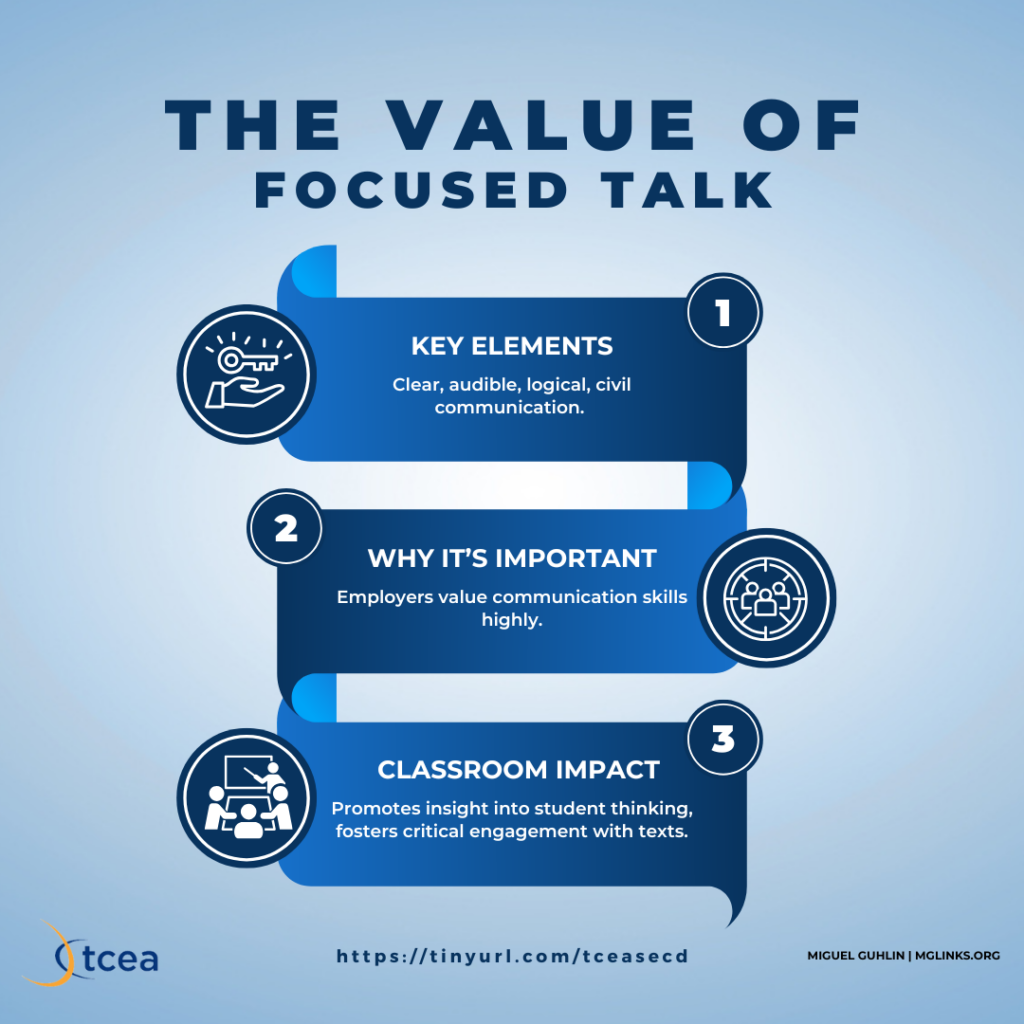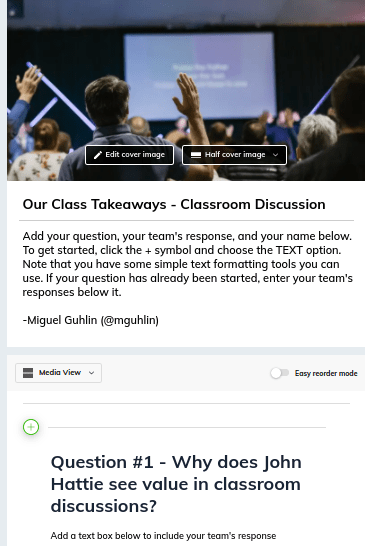Ready to electrify your classroom with strategy empowered classroom discussions? There are a variety of strategies you can use to engage students. Before we do that, though, let’s discuss why it’s important to hone our classroom discussion strategies.

The Value of Focused Talk
Mike Schmoker (2019) points out that focused talk should “punctuate” student readings of text. He says:
Virtually all text-based learning should be punctuated with—and then culminate in—focused talk, sometimes in pairs and at other times in extended full-class discussions or debates. All teachers should be able to instruct students in how to speak clearly, audibly, logically, and with civility.
When I do demonstration lessons, it is often apparent to me that students aren’t learning these essential communication skills, which rank at the top of what employers want (Gewertz, 2018 as cited by Mike Schmoker (2019)).
If you’ve been following the TCEA blog, you know that we’ve been sharing insights into how technology can enhance effective instructional strategies. While a lot of research isn’t available for these innovations, which Grant Lichtman describes as “changes that add value,” we can judge the results ourselves. Classroom discussion (d=.82) enjoys a powerful effect, more than two years’ growth.
Classroom discussions are not only about students connecting with content. Rather, classroom discussions provide the teacher with insight. The insight flows from understanding how much students are thinking and processing information. Like peering through the glass at Jungle Jim’s Playground to see that your child is safe in the ball pit, you are making a judgement about student learning. We often call this process a way of “making thinking visible” so we can assess learning.
Checking for Understanding
Teachers may not assess or check for understanding in the middle of classroom discussions. At least, that’s the point that Douglas Fisher and Nancy Frey make in their book, “Checking for Understanding” (see two chapters of their book). While researchers acknowledge that checking for understanding is critical to student success, there are many more ways to do so than using Think-Pair-Share.
In their book, they revisit several approaches we use in the classroom:
- Think-Pair-Share is a cooperative discussion strategy that allows students to discuss their responses with a peer before sharing with the whole class.
- Misconception analysis provides students an opportunity to discuss, often in small groups, misunderstandings that they have.
- Whip Around provides teachers with a check for understanding to assist them in determining whether they need to reteach content.
“For the majority of lessons, no evidence exists by which a teacher could gauge or report on how well students are learning essential standards,” says Mike Schmoker. Collecting this data that provides insights into classroom discussions your students have is essential. How else are you going to change how you’re teaching to better match student needs?
Many leaders in the field of literacy, as well as those in educational research, contend that in order for students to achieve at the highest levels, they must actively participate in learning through conversation, reading, and writing (Wilkinson and Silliman, 2000; Tovani, 2004; Daniels and Zemelman, 2004; Gallagher, 2004; Zwiers, 2008). Students develop deep conceptual knowledge in a discipline only by using the habits of reading, writing, and thinking (McConachie et al., 2006; Schleppegrell, 2004). (Source: Language magazine)
Let’s examine two ways that are effective and can work as stand-alones.
Strategy #1: Talk, Read, Talk, Write (TRTW)
Looking for a powerful, bare bones (strategy without technology) you can use to check for understanding? At a conference earlier this fall, an elementary teacher introduced me to Nancy Moseley’s TRTW. It is an approach that closely matches Schmoker, Fisher, Frey, and Hattie’s research.
[TRTW] was initially designed for the core classes, and its specific purpose is to help develop students’ abilities to read academic texts as the primary source of their learning. This, of course, implies the need to train them how to read that type of text successfully. Nancy’s book lays out the strategy and even discusses the need for building reading stamina specifically regarding academic texts as well as releasing more and more responsibility over to students for their learning in the classroom. Source: Amy Lenord
Let’s explore this below.
TRTW Example: Classroom Discussion
Here’s what those steps look like in the context of a professional learning session with adult learners.
- Talk 1 (before reading)
- Engage students with a question relevant to content area.
- Example: How do YOU get students excited about discussing texts in your classroom conversations?
- Set Purpose for Reading:
- Example: Discover some of the reasons why it’s important to focus on heightening classroom discussions.
- Engage students with a question relevant to content area.
- Read (during reading)
- Read Illuminate Learning’s blog entry. Read this individually or with your elbow partner.
- Make a list of key points in the blog to share with your team
- When done, let your partner know and move on to Step 3 together
- Talk 2 (after reading)
- Go to a digital space (e.g. Padlet work or Google Docs), and respond to the question(s) below. It is okay if different groups respond to the same question, but it would be nice to have some variety
- Question #1 – Why does John Hattie see value in classroom discussions?
- Question #2 – What are some technology tools that you have learned about today or already know about that you could use?
- Question #3 – What would happen if you were to adopt this strategy and/or technologies in your classroom?
- Go to a digital space (e.g. Padlet work or Google Docs), and respond to the question(s) below. It is okay if different groups respond to the same question, but it would be nice to have some variety
- Write
- In this step, you are going to engage in some writing. Here’s the situation your assistance is needed with:
Your school leader has approached your team and asked you to write a short email sharing the value of classroom discussion. This email will be shared with the entire campus team of professionals. - Add your short, brief piece of writing to the digital space you’ve been working on in the appropriate step.
- In this step, you are going to engage in some writing. Here’s the situation your assistance is needed with:
As you can see, TRTW offers some discussion opportunities. You can adapt other instructional strategies in the same way, such as Think-Puzzle-Explore.
Strategy #2: Think-Puzzle-Explore
In her blog on Sparking Student Curiosity, Michelle Lucas outlines several approaches she uses as a science educator. One of the approaches that she mentioned intrigued me. That strategy is Think-Puzzle-Explore. A quick search online yielded the elements of the approach:
-
- What do you think you know about this topic?
- What questions or puzzles do you have?
- How can you explore this topic? (Source: Visible Thinking)
This serves as a tangible way to capture data needed to successfully use classroom discussion.
Blending Technology into Classroom Discussion

There are a host of technologies you can use to capture the classroom discussions. Using a digital tool can assist in capturing the information in a few easy steps.
Create a digital space that has your Check-In Conversation strategy. This strategy enables “students to share their thoughts, questions, annotations about the text.” Padlet, one example, has the ability to handle a wide variety of media. This makes it a nice canvas where students can do that in response to your list of pre-made questions.
Blending technology into effective instructional strategies (e.g. Think-Puzzle-Explore and TRTW) empowers learning in several key ways. It reinforces the core components of the strategies that make them powerful for student learning.

